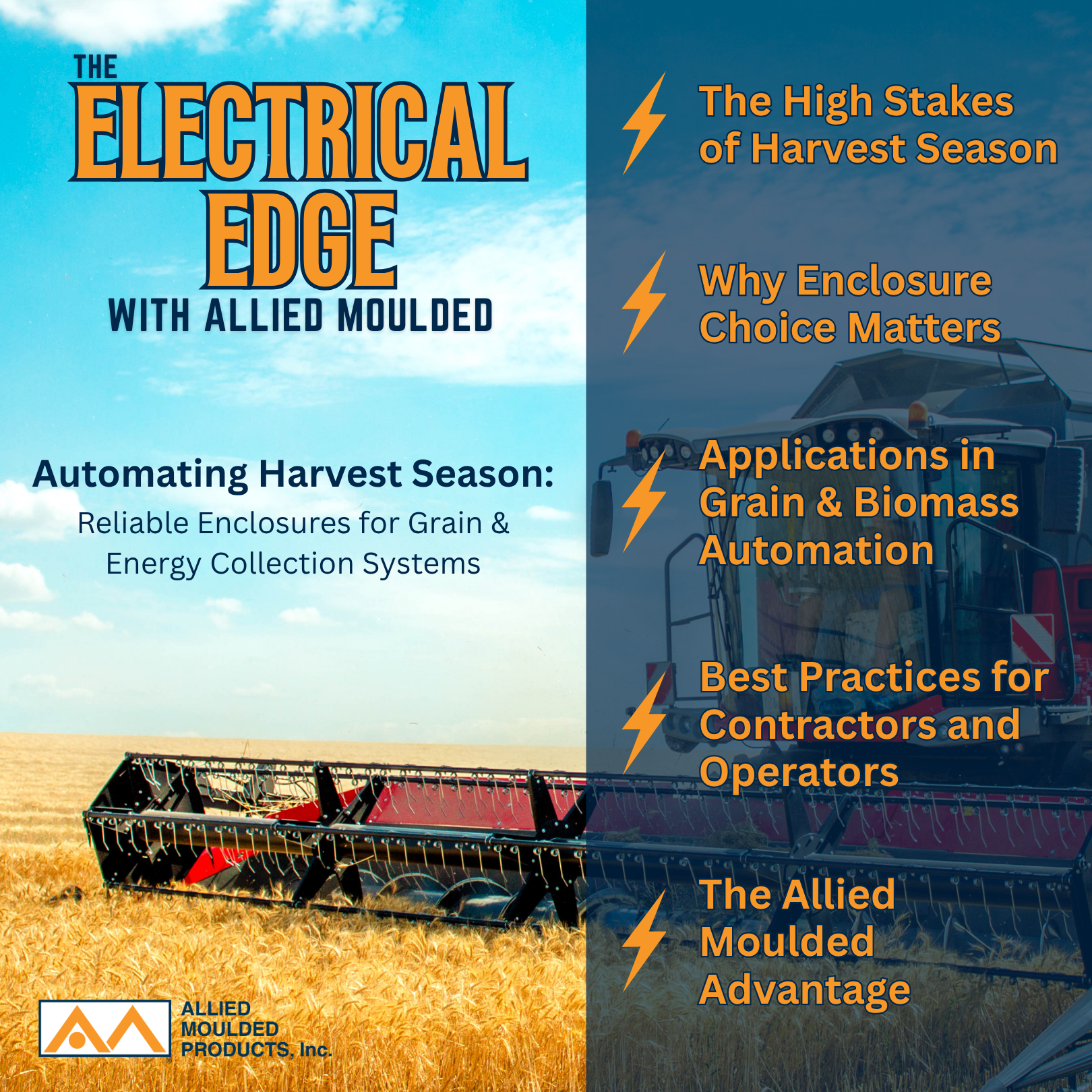
Harvest season is short, demanding, and unforgiving. When the grain is ready, farmers, contractors, and energy operators only get one shot to move, store, and process crops efficiently.
Automation has become the backbone of modern agriculture and biomass operations, driving everything from grain elevators and conveyors to digesters and energy collection systems.
But when the environment works against your equipment, even the smartest automation can grind to a halt. The unsung hero? The electrical enclosure that keeps controls safe from dust, humidity, vibration, and corrosion.
The High Stakes of Harvest Season
Every hour matters. A few hours of downtime during harvest can mean spoiled grain, delayed transport, or missed energy capture.
Unlike manufacturing facilities that run year-round, agricultural systems operate under intense seasonal deadlines. That makes reliability and resilience non-negotiable.
Yet grain and biomass operations present some of the harshest conditions for electrical equipment:
- Dust and debris: Grain dust is fine, pervasive, and combustible. If it infiltrates control systems, it can overheat components or create fire hazards. NEC Article 502 addresses these risks in hazardous (combustible dust) locations.
- Humidity and condensation: Cool autumn nights followed by warm days cause moisture to build inside poorly sealed enclosures. Condensation leads to corrosion, short circuits, and premature failure.
- Chemical exposure: Fertilizers, pesticides, and cleaning agents can accelerate wear, especially in metal enclosures.
- Vibration and impact: Augers, dryers, and conveyors generate constant vibration, putting stress on weakly built enclosures.
Why Enclosure Choice Matters
The enclosure is a frontline defense. Every sensor, motor starter, and control module depends on it to maintain operational integrity.
Choosing the wrong enclosure can turn into a costly mistake during harvest. That’s why material, rating, and gasketing are critical factors.
- NEMA Ratings: The right rating ensures the right protection. NEMA 4X enclosures are dust-tight, corrosion-resistant, and watertight — ideal for outdoor or washdown conditions. NEMA 12 enclosures provide indoor dust protection for control panels. For buried or heavy washdown applications, NEMA 6P is the go-to.
- Material selection: Stainless steel is strong but expensive and prone to corrosion in high-ammonia or chemical environments. Fiberglass reinforced polyester (FRP) offers strength, chemical resistance, and cost efficiency. Polycarbonate provides lightweight options with clear covers for easy visual checks.
- Gasket longevity: A good seal is only as reliable as its gasket. Polyurethane or silicone gasketing maintains compression and resists degradation from moisture, dust, and chemicals.
Applications in Grain & Biomass Automation
Automation isn’t just for big operations; it’s increasingly common in mid-size and even family-owned farms. Reliable enclosures are critical wherever automation and controls are deployed:
- Grain handling: VFDs and motor starters for augers, dryers, and conveyors; bin level sensors; and control panels at elevators all require dust- and moisture-resistant protection.
- Biomass energy: Enclosures protect pumps, agitators, and feed systems in digesters. Outdoor-rated boxes house sensors and controls at farm-based energy recovery facilities.
Best Practices for Contractors and Operators
- Match NEMA rating to the environment: Don’t use a NEMA 12 enclosure outdoors. Use NEMA 4X for dusty, corrosive, or washdown-prone applications.
- Plan for future expansion: Specify boxes with extra space for future conductors or added sensors.
- Prioritize access: Hinged and lockable covers simplify maintenance without compromising security.
- Account for vibration: Use rugged materials like fiberglass and ensure proper mounting hardware is included.
- Resist corrosion: In dusty or humid environments, fiberglass or polycarbonate often outperforms mild steel.
The Allied Moulded Advantage
Allied Moulded offers enclosures designed specifically for environments like agriculture and biomass. Products like the AM Series and ULTRALINE® are built with rugged fiberglass construction and formed-in-place gaskets that withstand years of vibration, dust, and moisture.
Polycarbonate clear-cover models allow operators to check indicator lights or sensor readings without opening the box. And because Allied Moulded enclosures are Made in the USA, contractors and distributors can count on reliable lead times, even during the busiest harvest window.
Reliability When It Matters Most
Harvest season doesn’t wait for a re-inspection or a replacement shipment. Your automation is only as strong as the enclosures protecting it.
With Allied Moulded’s fiberglass and polycarbonate solutions, you can keep grain moving, digesters running, and operations online when every second counts.
Rule of Thumb: If your enclosure can’t handle dust, moisture, and vibration at the same time, it’s not built for harvest season.
